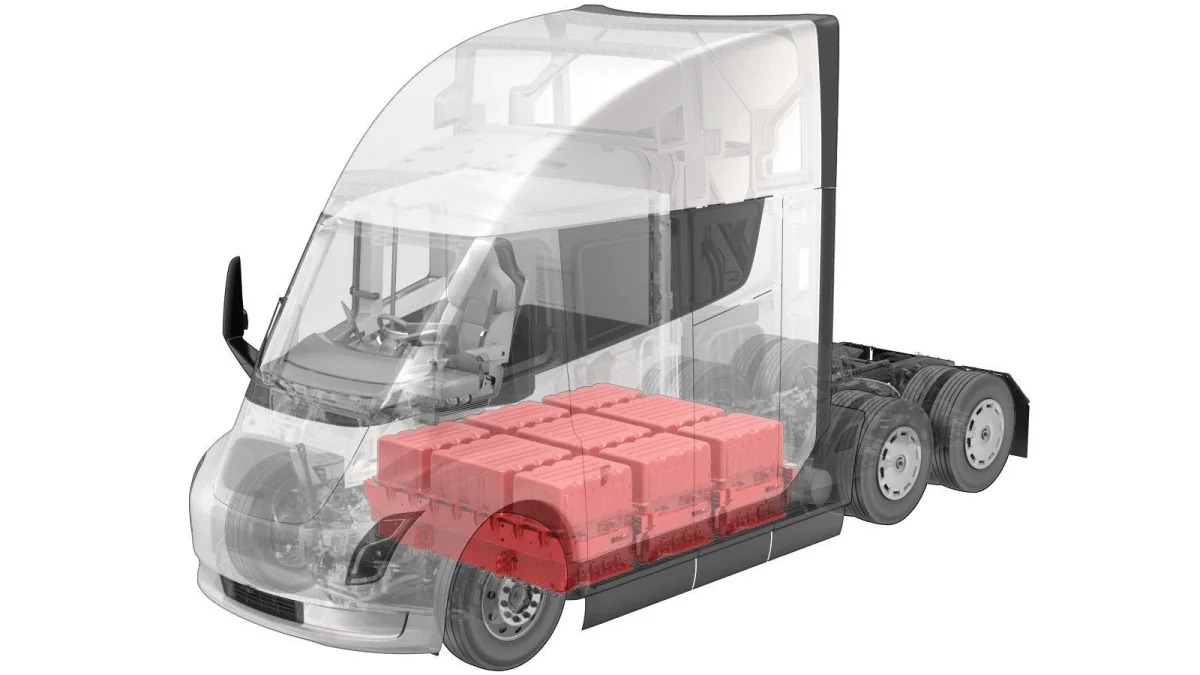Twitter user Greentheonly makes a habit of rooting through Tesla's software and back end. After a digital dive into Tesla's online parts catalog just before the end of 2022, he came up with parts diagrams for the Tesla Semi that show the arrangement of battery modules and a few subsystems. Even better, there was a sample VIN sticker providing a few figures we outsiders are still waiting for. Starting with upper left on the sticker, the Semi's gross vehicle weight rating is given as 22,135 kilograms or 48,800 pounds. This is not the weight of the Semi; just as with a car or pickup truck, it's how heavy the Semi is allowed to legally be. The first column, GAWR, stands for Gross Axle Weight Rating. The three figures identify the maximum weight each of the Semi's three axles is legally allowed to bear, and these three numbers add up to the same 22,135 kg or 48,000 pounds as the GVWR.
When a tractor and trailer pull onto a scale, the scale ticket shows the weight on the front axle, called the steerer, the total weight on the two axles behind the cab, called the drivers, and the total weight on the two axles on the trailer, called the tandems. On a standard ICE over-the-road truck, the limits are 12,000 pounds for the steerer, 34,000 pounds for the drivers (17K + 17K), and 34,000 pounds for the tandems (17K + 17K). That's how you get the 80,000 max loaded weight most people are familiar with regarding over-the-road trucks. The numbers for the Semi are 12,600 on the steerer and 36,200 on the drivers, 2,800 pounds more than those for a traditional diesel-powered tractor.
Electric Class 8 trucks get an additional 2,000-pound overall allowance when loaded, legally weighing up to 82,000 pounds on the haul. With the Semi, then, the 800 pounds the tractor uses beyond the allowance are deducted from the maximum legal weight the tandems can support. Instead of the two trailer axles weighing up to 34,000 pounds when pulled by a diesel tractor, a trailer hooked to the Semi would be able to legally support 33,200 pounds over its tandems. That is not inconsequential, but not a deal-breaker without more context. All we can say is that because it's possible for a tractor-trailer to be under the total legal maximum but be over the maximum legal weight on a set of axles — like the tractor-trailer weighs 78,500 pounds but it's impossible to get the drivers or tandems under 34,000 pounds — there's a chance the Semi's biggest challenge will be balancing the load on an 82,000-pound haul.
Here's what's most important: These numbers don't tell us how much the tractor weighs, only how it has to distribute weight. When hooked to a fully loaded trailer, a fair bit of the weight on the drivers comes from the weight of the trailer nose and the cargo sitting in or on the front of the trailer.
Brian Wang at Next Big Future created a chart comparing the Semi to other electric trucks. He assigns the 500-mile Semi a tractor weight of 26,000 pounds and a payload rating of 44,000 pounds. He puts the 300-mile Semi at a tractor weight of 20,500 pounds and a payload weight of 46,500 pounds. In both cases, the total comes to 70,000 pounds. We have no idea where the figures come from, and Wang doesn't say.
Frankly, no matter how much parsing we do, it won't much matter until we have more information. We are again comparing the Semi to an over-the-road truck, which is not the Semi's use-case. As we said before, the Semi is a day cab designed to shuttle goods on short regional routes, and day cabs aren't usually loaded to the federal maximum. But the Semi looks like an over-the-road truck and Tesla keeps talking about it like an over-the-road truck, so it's constantly compared to an over-the-road truck.
Moving on to the other goodies in the trove, the drawings show the modular battery arrangement with nine meaty packs under the cab floor. There's an image with the megacooling module at the charge port for keeping temps down during megawatt-level charging. And Tesla's engaged in the cuteness of name the drivers Torque and Efficiency. Torque is the one closest to the cab, its two motors called into action for accelerating and heavy pulls, Efficiency's single motor runs by itself during steady-state cruising.










Sign in to post
Please sign in to leave a comment.
Continue